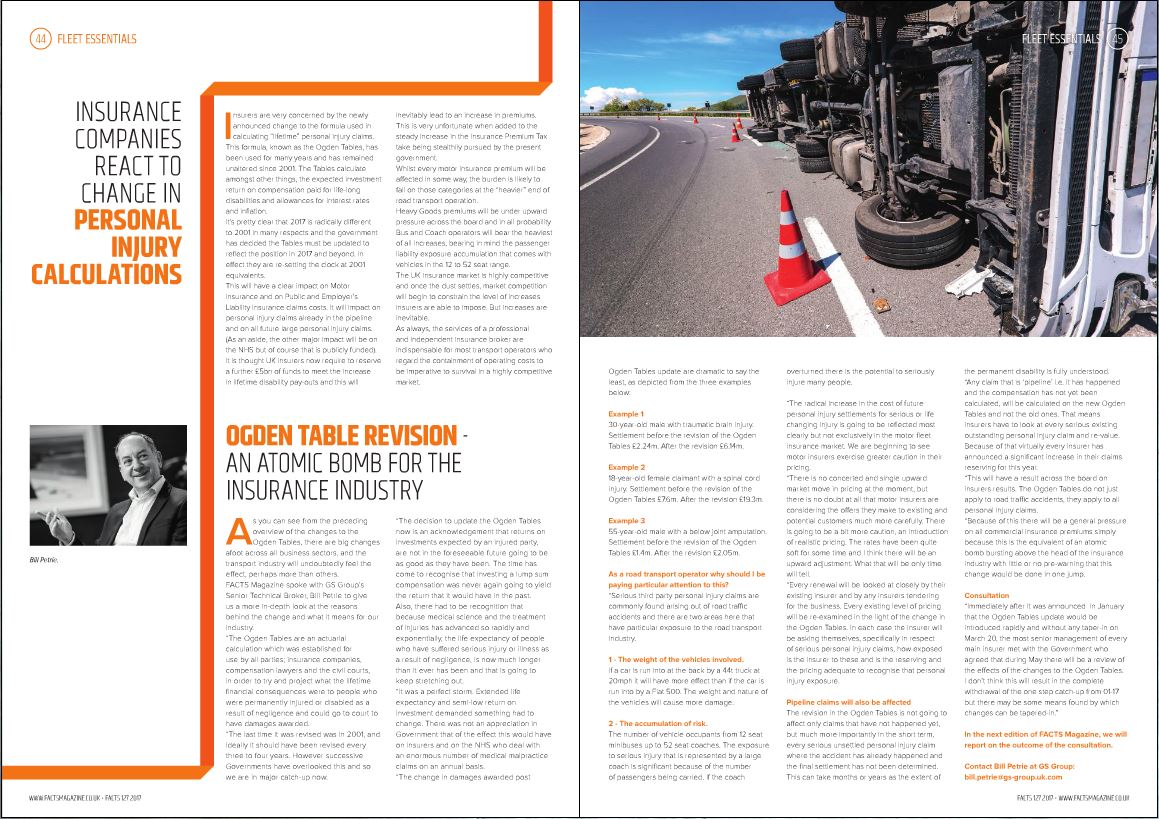News
Insurance Companies React to Change in Personal Injury Calculations

In light of the recent revision to the Ogden table, Senior Technical Broker, Bill Petrie, spoke to FACTS magazine to give an in-depth look at the reasons behind the change and what it means for the transport industry.
Insurers are very concerned by the newly announced change to the formula used in calculating “lifetime” personal injury claims. This formula, known as the Ogden Tables, has been used for many years and has remained unaltered since 2001. The Tables calculate amongst other things, the expected investment return on compensation paid for life-long disabilities and allowances for interest rates and inflation.
It’s pretty clear that 2017 is radically different to 2001 in many respects and the government has decided the Tables must be updated to reflect the position in 2017 and beyond. In effect they are re-setting the clock at 2001 equivalents.
This will have a clear impact on Motor Insurance and on Public and Employer’s Liability Insurance claims costs. It will impact on personal injury claims already in the pipeline and on all future large personal injury claims. (As an aside, the other major impact will be on the NHS but of course that is publicly funded). It is thought UK insurers now require to reserve a further £5bn of funds to meet the increase in lifetime disability pay-outs and this will inevitably lead to an increase in premiums. This is very unfortunate when added to the steady increase in the Insurance Premium Tax take being stealthily pursued by the present government.
Whilst every motor insurance premium will be affected in some way, the burden is likely to fall on those categories at the “heavier” end of road transport operation. Heavy Goods premiums will be under upward pressure across the board and in all probability Bus and Coach operators will bear the heaviest of all increases, bearing in mind the passenger liability exposure accumulation that comes with vehicles in the 12 to 52 seat range.
The UK insurance market is highly competitive and once the dust settles, market competition will begin to constrain the level of increases insurers are able to impose. But increases are inevitable.
As always the services of a professional and independent insurance broker are indispensable for most transport operators who regard the containment of operating costs to be imperative to survival in a highly competitive market.
Ogden Table Revision – An Atomic Bomb for the Insurance Industry
As you can see from the preceding overview of the changes to the Ogden Tables, there are big changes afoot across all business sectors, and the transport industry will undoubtedly feel the effect, perhaps more than others. FACTS Magazine spoke with GS Group’s Senior Technical Broker, Bill Petrie to give us a more in-depth look at the reasons behind the change and what it means for our industry.
“The Ogden Tables are an actuarial calculation which was established for use by all parties; insurance companies, compensation lawyers and the civil courts, in order to try and project what the lifetime financial consequences were to people who were permanently injured or disabled as a result of negligence and could go to court to have damages awarded.
“The last time it was revised was in 2001, and ideally it should have been revised every three to four years. However successive Governments have overlooked this and so we are in major catch-up now.
“The decision to update the Ogden Tables now is an acknowledgement that returns on investments expected by an injured party, are not in the foreseeable future going to be as good as they have been. The time has come to recognise that investing a lump sum compensation was never again going to yield the return that it would have in the past. Also, there had to be recognition that because medical science and the treatment of injuries has advanced so rapidly and exponentially, the life expectancy of people who have suffered serious injury or illness as a result of negligence, is now much longer that it ever has been and that is going to keep stretching out.
“It was a perfect storm. Extended life expectancy and semi-low return on investment demanded something had to change. There was not an appreciation in Government that of the effect this would have on insurers and on the NHS who deal with an enormous number of medical malpractice claims on an annual basis.
“The change in damages awarded post Ogden Tables update are dramatic to say the least, as depicted from the three examples below:
Example 1
30-year-old male with traumatic brain injury. Settlement before the revision of the Ogden Tables £2.24m. After the revision £6.4m.
Example 2
18-year-old female claimant with a spinal cord injury. Settlement before the revision of the Ogden Tables £7.6m. After the revision £19.3m.
Example 3
55-year-old male with a below joint amputation. Settlement before the revision of the Ogden Tables £1.4m. After the revision £2.05m.
As a toad transport operator why should I be paying particular attention to this?
“Serious third party personal injury claims are commonly found arising out of road traffic accidents and there are two areas here that have particular exposure to the road transport industry.
1 – The weight of the vehicles involved.
If a car is run into at the back by a 44ft truck at 20mph it will have more effect than if the car is run into by a Fiat 500. The weight and nature of the vehicles will cause more damage.
2 – The accumulation of risk.
The number of vehicle occupants from 12 seat minibuses up to 52 seat coaches. The exposure to serious injury that is represented by a large coach is significant because of the number of passengers being carried. If the coach overturned there is the potential to seriously injure many people.
“The radical increase in the cost of future personal injury settlements for serious or life changing injury is going to be reflected most clearly but not exclusively in the motor fleet insurance market. We are beginning to see motor insurers exercise greater caution in their pricing.
“There is no concerted and single upward market move in pricing at the moment, but there is no doubt at all that motor insurers are considering the offers they make to existing and potential customers much more carefully. There is going to be a bit more caution, an introduction of realistic pricing. The rates have been quite soft for some time and I think there will be an upward adjustment. What that will be only time will tell.
“Every renewal will be looked at closely by their existing insurer and by any insurers tendering for the business. Every existing level of pricing will be re-examined in the light of the change in the Ogden Tables. In each case the insurer will be asking themselves, specifically in respect of serious personal injury claims, how exposed is the insurer to these and is the reserving and the pricing adequate to recognise that personal injury exposure.
Pipeline claims will also be affected
The revision in the Ogden Tables is not going to affect only claims that have not happened yet, but much more importantly in the short term, every serious unsettled personal injury claim where the accident has already happened and the final settlement has not been determined. This can take months or years as the extent of the permanent disability is fully understood.
“Any claim that is ‘pipeline’ i.e. it has happened and the compensation has not yet been calculated, will be calculated on the new Ogden Tables and not the old ones. That means insurers have to look at every serious existing outstanding personal injury claim and re-value. Because of that virtually every insurer has announced a significant increase in their claims reserving for this year.
“This will have a result across the board on insurers results. The Ogden Tables do not just apply to road traffic accidents, they apply to all personal injury claims.
“Because of this there will be a general pressure on all commercial insurance premiums simply because this is the equivalent of an atomic bomb bursting above the head of the insurance industry with little or no pre-warning that this change would be done in one jump.
Consultation
“Immediately after it was announced in January that the Ogden Tables update would be introduced rapidly and without any taper-in on March 20, the most senior management of every main insurer met with the Government who agreed that during May there will be a review of the effects of the changes to the Ogden Tables. I don’t think this will result in the complete withdrawal of the one step catch-up from 01-17 but there may be some means found by which changes can be tapered-in.”
To access the full article on Page 44 of the latest FACTS magazine, click here.

